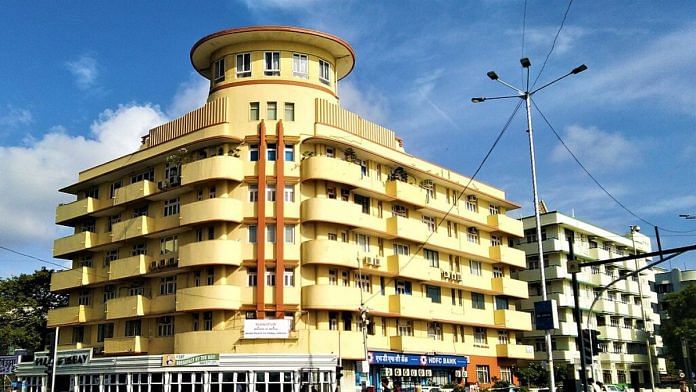In the early 20th century, Bombay stood at the crossroads of empire, migration, and modernity, emerging as the focal point of modernism in the Indian subcontinent. While Calcutta and Madras shared similar morphology—both being trading ports and sites of global exchange—Bombay was unique, cosmopolitan, and a crucible of cultural experimentation and architectural transformation.
But how did Bombay outrun Calcutta and Madras in aesthetic innovation? What events led it to distinctly project a modernist urban identity? Who was behind this drastic transformation that made Bombay catch this global modern wave? Why Bombay? Why not any other Asian city? And how exactly?
Here’s a story on how a local version of modernism that was both global in form and regional in spirit was shaped by the people of Bombay.
The Rise of a modern metropolis
By the 1920s, Bombay was bursting with industries, manufacturing units, and people. Overcrowding in the City of Seven Islands, coupled with industrial expansion and plague outbreak, prompted the city administration to shift attention toward suburban development, especially in Salsette Island, the island north of Bombay. This was not just a response to urban congestion but an opportunity to reimagine the city’s built environment.
The mistakes made by the Bombay City Improvement Trust in the island city could be resolved in the suburbs. Hence, a new body was formed—the Bombay Development Department (BDD)—in 1920, which aimed to create suburban schemes in Salsette for the upper and middle classes of Bombay. Acquiring land from the Indian villagers of Salsette, creating roads and then demarcating new uniform plots was the groundwork laid for suburban planning by the BDD. Unlike the chawls for the working class and the colonial bungalows of the elites, something new was needed. This took shape in the form of new modern architectural typologies—detached appropriated villas, and apartments which catered specifically to a unique set of people—the burgeoning middle class.

The middle class of Bombay itself was unique. The English-educated, white-collar job-going, upper-caste people, after saving a good percentage of their income, were left with just enough money to live through the vagaries of life—some characteristic features of the Bombay middle class. No one knew better functional and economic efficiency than them. Further, unlike the working class, they were educated. Partly with the knowledge of modern hygiene and a strong desire to be categorised away from the working class, they adhered to the modern forms of hygiene and sanitation. This meant standardised living, modern flushing toilets, and houses in well-planned neighbourhoods with clean air and water, which was hardly possible for the middle class in the island city; hence the suburbs. This also meant embracing new and modern ways of living, which entailed modern style and aesthetics—houses designed in Western styles.
In the 1930s, the striking Art Deco style was considered modern worldwide. Miami and Paris had houses, furniture, and artefacts designed in Art Deco. The elites in Bombay were at par with Parisians and Miamians. They built houses with curved balconies, geometric motifs, and streamlined facades, and had sleek furniture and furnishings.
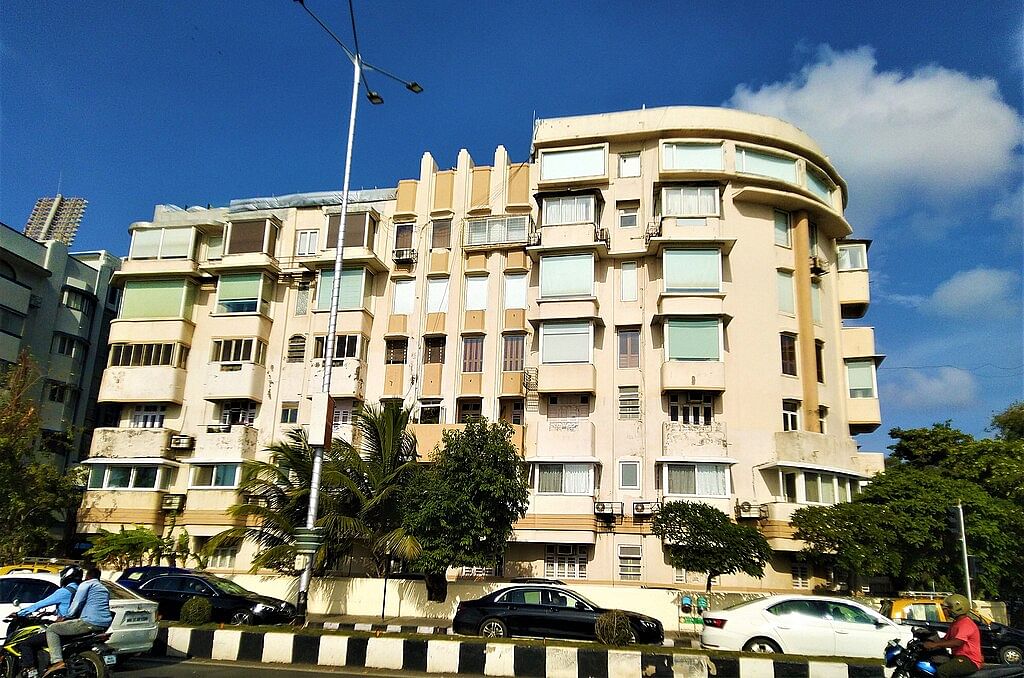
Inspired by the elites, the middle class built similar houses, bought similar furnishings, and equipped their homes with modern-looking tiles and kitchen and toilet appliances. Houses designed with Art Deco aesthetics could be seen popping up in the suburbs of Juhu, Bandra, and Khar. At this point of time, Art Deco became a bold cultural symbol for anything which was modern. It got more popular with the Ideal Home Exhibition of 1937, a first-of-its-kind architectural exposition in India, organised by the Indian Institute of Architects, which displayed reinforced concrete models, modern bathroom fixtures, and ferrocement innovations. It brought global design sensibilities to an Indian middle class hungry for aesthetic modernity.
Modernism was not just about architectural style, it was about breaking from the past, making progress, and creating new social norms. People who came from villages had strong notions of caste purity and pollution. To an extent, these were dissolved in Bombay. Partly due to English education and partly because of colonial urbanity, Indians had to share spaces with people of other caste, religion, ethnicity, and other sub identities—something which would be unimaginable in the villages—in local trains, offices, and also their new homes and neighbourhoods. With toilets coming inside the houses, new notions of caste pollution and purity were formed. Sharing a compound space and walls with people of other castes and religions meant breaking a centuries-old tradition of caste purity, while forming new notions of cosmopolitanism provided through the ideas of progress and development.
Also read: How Jaisalmer architecture cools its buildings. It has the answer to heat in Indian cities
The middle class as agents of modernism
A unique feature of Bombay’s modernism movement was that it was not entirely state-led or elite-driven. Instead, it was shaped significantly by the aspiration and agency of the middle class. Through English education, credit networks, and political mobilisation, Bombay’s middle class actively participated in reimagining domestic and urban life. The suburbs became sites where this new identity unfolded—not just architecturally, but socially. For example, in neighbourhoods like Vile Parle, Santa Cruz, and Bandra, residents petitioned municipal authorities and the BDD for better infrastructure—roads, drainage, sewage system, and amenities like hospitals, playgrounds, temples, and schools. It was not just the Art Deco cinemas like Eros and Regal which were modernised, but playgrounds and reading rooms got a modern makeover too.

In 1925, the Vile Parle residents’ association wrote to the municipality to create a literary association which would be inclusive and accessible to everyone. In 1946, Khar residents asked the municipality to develop a reading room in Khar which could be used by people of every caste, creed, and religion. In 1922, middle class residents of Santa Cruz wrote to the Santa Cruz municipality asking to develop a hospital for the use of everyone in the community. In the 1930s, the residents of Khar asked the municipality to establish a Ramakrishna Mission Ashram in the locality, which could be used for everyone even though it was a religious building. The design of the building was modernist—simple, plain façade with no ornamentation, curved canopy, geometric pattern in iron grill on windows. Not only the architectural style of the reading room or the Ramakrishna Mission Ashram was inspired by modern Art Deco, but the idea and rationale behind the creation of such a space was also modern.
Modernism on the one hand meant modern hygiene and infrastructure, but on the other hand, it also meant empowerment to demand these things. The middle class was empowered to an extent that resistance in the form of petitions, delegations, and press was prominent in the 1930s. Local resistance and advocacy shaped these suburban spaces of Bombay, embedding notions of self-governance and civic modernity into the urban fabric of Bombay. The files at the Maharashtra State Archives are filled with petitions from individuals, groups, resident associations, and press cuttings detailing how the middle class would conduct public meetings, make resolutions, and draft letters addressed to the municipal boards asking for better infrastructure, better roads, drainage system, seawalls and sluices, better administration, and less taxes. This grasp on colonial laws and bureaucratic rationality, knowledge of rights and freedom, and English-speaking capability shows that the middle class was modern in social terms not in just superficial terms.
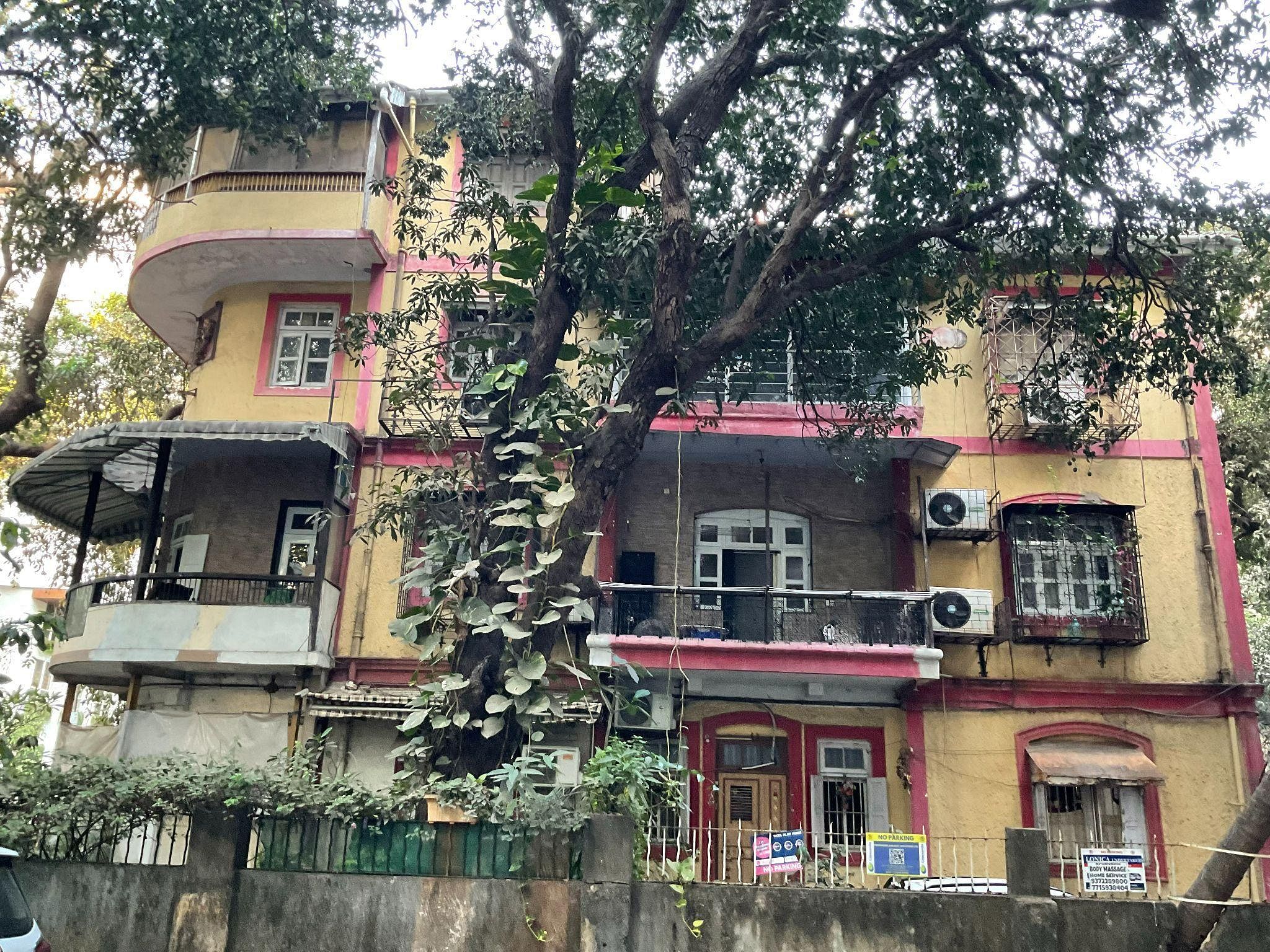
Modernism was also present inside the houses, not just outside. Perhaps the most intimate expressions of Bombay’s cultural modernism occurred inside the house. As historian Jordan Sand argues, modernism often took root not in monumental public spaces but in the private realm. In Bombay, this meant functional internal planning. While houses before the modernisation had halls which were used for multiple functions, modern houses in Bombay meant areas designated for every purpose. But connecting and arranging these areas in order to get enough light and ventilation was not an easy task and thus builders, architects, and designers (all inspired by modernist style) were hired. Modern houses in Bombay, like Vilhervin in Bandra, had the living-cum-drawing room becoming the fulcrum of the house, located spatially close to the kitchen and bedrooms, with the staircase, located at the front with a different entrance, and toilets at the end. These houses were embellished with imported bathroom fittings, mosaic-tiled floors, teakwood furniture inspired by Bauhaus ideals, and kitchens reconfigured for hygienic living.
The Beautiful Homes column in The Times of India and illustrated guides in the Indian Concrete Journal propagated ideals of the modern Indian home. These publications suggested that to be modern was not merely to live in a new building but to inhabit it in new ways—through rational spatial planning, efficient fixtures and furniture, and new consumer products. The Art Deco architecture and modernist interiors created a hybrid aesthetic: Western in influence but adapted to Indian lifestyles. Balconies became transitional zones for prayer and gossip; drawing rooms reflected a blend of Persian carpets and chrome-legged chairs. This adaptation, far from being derivative, reflected a vernacular modernism that was distinctly Bombay.
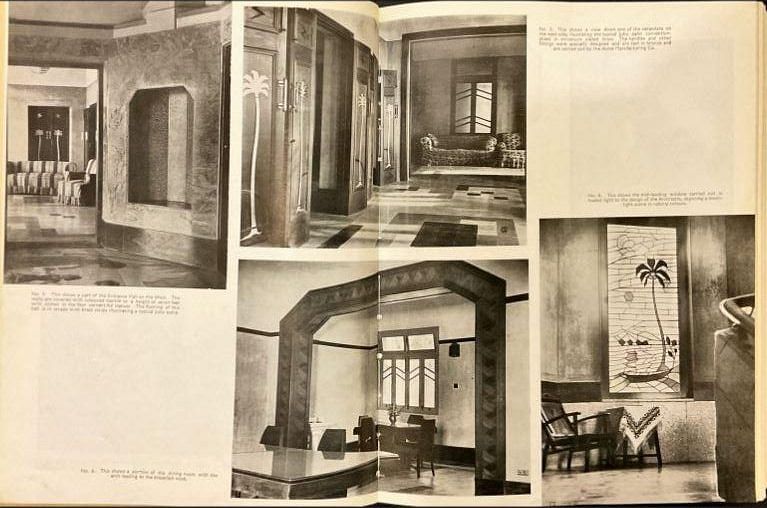
Parallel currents in Madras and Calcutta
While Bombay emerged as a visual and spatial emblem of modernity in the Indian subcontinent, Madras and Calcutta cultivated their own modernist movements, albeit along different trajectories. In Madras, modernism was shaped by its intellectual and bureaucratic elite. The city’s urban transformation in the early 20th century was less dramatic than Bombay’s, but equally significant. Modernism in Madras, by virtue of Art Deco, became visible in cinema theatres like Casino, preview halls of Gemini, AVM, and Vijaya Vauhini studios, commercial buildings like Dare House, hotels such as Oceanic and Dasaprakash, and in residential areas including T Nagar, Mylapore, Alwarpet, and Adyar.
Architects from the Government College of Architecture in Guindy experimented with tropical modernism—designing homes and public buildings that responded to heat, humidity, and vernacular forms. The Madras School of Art (now Government College of Fine Arts), under figures like KCS Paniker became a hub for modernist expression in painting, blending indigenous symbolism with abstraction.
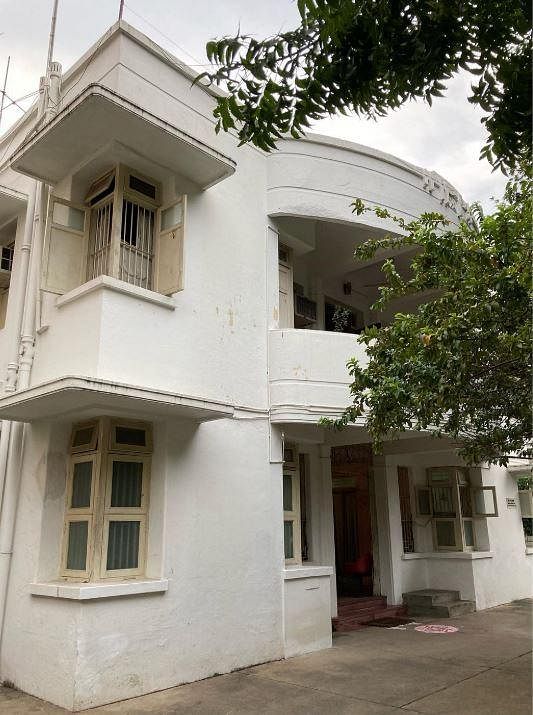
Meanwhile, Calcutta, once the imperial capital, bore the weight of colonial legacy and radical politics. Its modernism was deeply intertwined with the Bengal Renaissance and Leftist intellectual circles. Writers, artists, and architects in Calcutta grappled with questions of identity, class, and social justice.
Calcutta’s rich legacy of Art Deco architecture and therefore modernism—blending Western styles with Indian traditional elements—is clearly visible in the iconic Victoria House, Metro Cinema, the Shyambazar Mullick House, and the Seksaria House. Modernism in Calcutta is well depicted in its residential neighbourhoods like Southern Avenue, Jodhpur Park, and Lake Gardens. Modernist architecture appeared in pockets—through the works of Habib Rahman and others who studied in the West. But Calcutta’s modernism was perhaps more ideological and literary than visual. The proliferation of the ‘little magazine’ culture and the influence of Marxist thought shaped a version of cultural modernism steeped in debate, art, and radical politics.
What set Bombay apart was its middle class. There were elites in both Calcutta and Madras and one can find bigger Art Deco bungalows and cinemas built for the elites. However, the middle class and its emulation to be modern was what was missing in both Calcutta and Madras. And this is reflected in the mundane-looking yet profound simple Art Deco houses for the middle class in Bombay. Public housing for the non-elites came in Bombay before any other Asian cities. Further, the non-elites were shaping, re-shaping, and appropriating it constantly. This agency of the non-elite middle class is unique to Bombay, making it different from any other city. There were reading rooms and spaces where these discussions and discourses on “being modern” were formed. Additionally, there were cinemas and theatres which made this information accessible for the middle class. This reinforced Bombay’s image as the beating heart of modernism in the Indian subcontinent.
Also read: Ratnagiri vs Mumbai—What ‘All We Imagine as Light’ gets horribly wrong about cities, Bahujans
The legacy of Bombay’s modernism
Bombay’s modernism was not a singular, linear movement, but one driven by aesthetic, social, and spatial practices. It emerged from a convergence of material conditions—overcrowding, technological innovations like reinforced concrete, new professional networks of architects—as well as intangible aspirations for cosmopolitanism, progress, and self-definition. Compared to the intellectual modernism of Calcutta or the climatically responsive architecture of Madras, Bombay’s modernism was visual, performative, and deeply embedded in everyday life. The interesting and often overlooked question is: who actually built those modern spaces? And the answer is, the middle class. Those who are ubiquitous but have been seldom given any recognition. They used tools like bureaucracy, knowledge of their rights and social capital, and networks to emulate the modern ways of living, which reflected in the spaces they inhabited.
From suburban neighbourhoods to Deco reading rooms and curated interiors, modernity in Bombay was lived and experienced at every level of the city. Today, remnants of this modernist past survive in fading murals, crumbling facades, heritage public buildings, and old family homes.
Sabine Ameer is an architect-urban planner and a doctoral researcher in International Relations at the University of Glasgow. She tweets @Sabineameer.
Views are personal.
(Edited by Aamaan Alam Khan)



